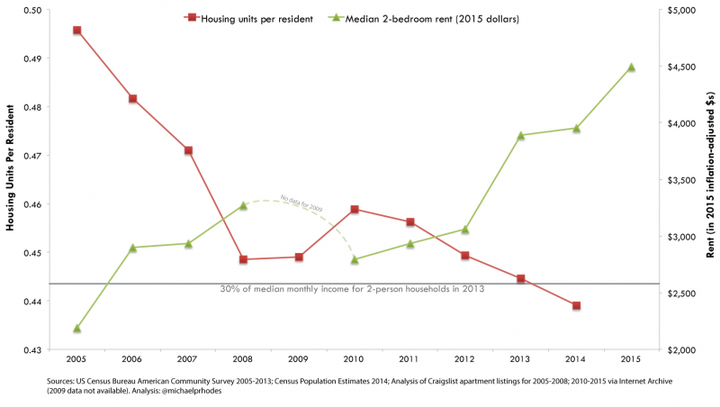
This story originally appeared on Citylab.
San Francisco is bound and determined to see through a moratorium on building new housing in the Mission District.
Back in June, the city’s Board of Supervisors voted 7–4 in support of a 45-day moratorium on new construction in the Mission. The vote fell short of the high bar required to enact an emergency measure; instead, residents will vote on the matter directly. Officials certified last week that a measure to halt all market-rate construction in the Mission for 18 months will appear on the November 3 ballot.
“Our goal is not to stop all development,” said Edwin Lindo, vice president for external affairs for the San Francisco Latino Democratic Club, in an interview with the San Francisco Business Times. “Our goal is to stop incredibly large development that focus exclusively on market-rate housing.”
As the Greeks say, there's nothing more permanent than the temporary. Independent of the ballot referendum, the Planning Commission just voted 5–1 to consider a measure that would slow down construction in the Mission, this one lasting for six months.* If the ballot measure passes in November, a moratorium lasting into 2018 will be greeted as a victory by activists and advocates. Even if it loses, the city still has the power to gum up construction in the Mission.
San Francisco is in the grips of a condo construction revolt. But stopping new construction won’t do anything to curb a rents crisis in the Mission. At best, it will exacerbate unaffordable rents in other neighborhoods. Residents have misdiagnosed the problem in the Mission, but they’re moving straight to a solution as radical as amputation.
One reason a Mission moratorium is a bad idea: It won’t actually do anything. There isn’t that much construction to be prevented in the Mission in the first place. A mere 141 units are approved in the Mission right now, and fewer than 100 new units per year have been added to the neighborhood over the last 15 years.
This lack of new construction is the source of the housing crisis in San Francisco. It’s hard to come by a cleaner demonstration of the mismatch between supply and demand anywhere else in the country. San Francisco is in a housing drought.s

“The Mission has become hyper-gentrified without very much new housing development,” writes Kristy Wang, community planning policy director for theSan Francisco Planning and Urban Research Association. “Development is getting blamed when in fact the Mission has become expensive because the supply of available housing is so limited.”
Even as the Mission failed to build new housing to match the city’s population growth, the neighborhood was hit especially hard by Ellis Act evictions. The sting of those evictions may be driving the sentiment against developers today.SocketSite, a San Francisco real-estate blog, notes that the Mission has suffered more no-fault evictions than any other planning district in San Francisco. Between 2005 and 2014, some 764 rent-controlled units were converted through evictions, including 396 Ellis Act evictions and 274 owner move-in evictions.
While these figures from the Mission aren’t astronomical, they represent recent highs for San Francisco. Among the city’s planning districts, the Mission recorded the highest number for no-fault evictions, the highest number for Ellis Act evictions, and the second-highest number for owner move-in evictions. But take these figures in perspective: They’re nowhere close to a high-water mark for San Francisco. Peak eviction came to the city in the late 1990s.
What has transpired since then is a period of moribund housing construction and extreme growth in employment and incomes driven by Silicon Valley. Which takes us to the present day. Voters are preparing to cement the dynamic that has led to the affordability crisis in the first place.
When San Francisco formally adopts a position against new construction in one neighborhood, it could easily spread like a flu to other neighborhoods. Indeed, it’s a bug that the city has picked up from its own suburbs, whose failure to build new housing, including new affordable housing, has helped to speed a dramatic rise in rents throughout the Bay Area. This comes at a time when San Francisco is finally poised to begin building supply in earnest. A temporary moratorium could be anything but temporary.
Voters may think that putting a stop to market-rate housing will somehow curb demand in San Francisco. In fact, residents have witnessed for years the results of a failure to build. What the city must do: Drop its protectionist attitude toward taller and denser residential construction, affirm (and enforce) truly inclusionary housing requirements, and ease the regulatory path to building housing projects for the so-called “missing middle.”
As SPUR notes, the city is taking some steps toward these goals. A moratorium on new construction would run contrary to all of them. Let’s face it: Probably there is no level of additional supply that can meet the extraordinary demand in San Francisco. Certainly not in a way that preserves the city in amber. But the shortest path to destroying the San Francisco that residents know and love is the road they’ve already chosen.